Home > Education & Expertise > Downwind and Light Wind Sails > Code Zero

Code Zero Sail
The Code Zero is a spinnaker-genoa hybrid. It’s designed to operate like a genoa but considered a spinnaker under racing rules (depending on its dimensions). This cruiser’s dream sail helps a boat’s performance in close reaching angles, especially in lighter winds, by generating much more speed than a slightly eased head sail. These sails also reach very well in moderate wind. A low stretch Vectran/Dyneema line or a torsion cable is normally used for the luff, and the sail is tensioned firmly to get a straight luff (a lot like a genoa).
A Code Zero has a mid girth of 75% of the foot length, so it measures as a spinnaker but has a much bigger area than a genoa. The optimal wind speed for this sail is 3 to 18 knots true wind speed and in lighter winds, you can carry this sail up to a 45-degree true wind angle. Typically they are designed to be flatter than a spinnaker and have a straight leech exit.
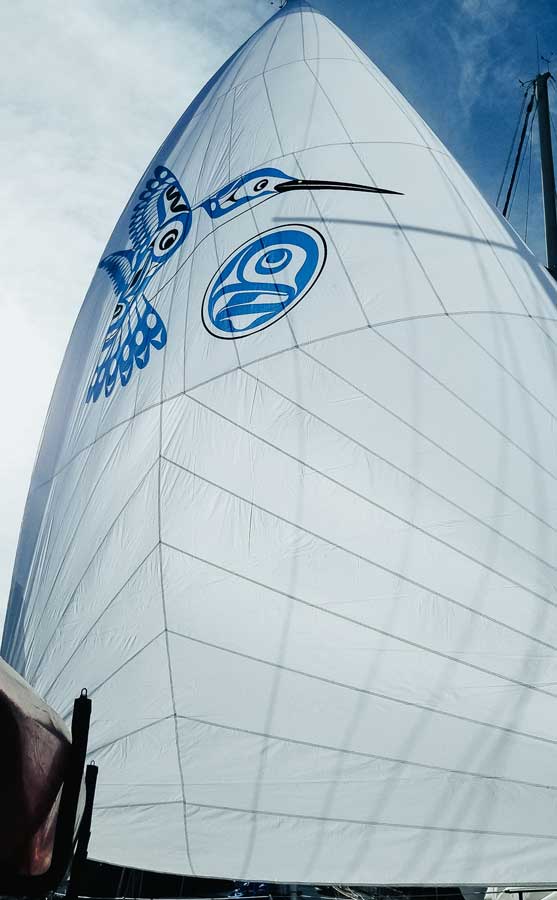
High-quality Code Zeros that’ll stand the test of time, no matter what you’re up to.
What makes a code zero.
The Code-Zero should be recognized as a spinnaker in the racing community, which means it must have a Mid Girth (MGM) no less than 75% of the Spinnaker Foot Length (SF).
The Code-Zero should have a solid luff, unlike drifters or Asymmetric Spinnakers which are free-run, attached only at the head, tack, and clew. The Code-Zero is run off of a dyneema or torsion line that keeps the luff straight and more rigid allowing it to point higher than an asymmetrical spinnaker but has a Leech Curve (as opposed to a hollow) increasing Sail Area and allowing the sail to power properly in low winds.
The torsion line is either built directly into the luff of the sail, or will use a system such as a zipper luff which allows the torsion line to be installed and removed easily. Often furling systems such as Harken Reflex, or Profurl SPINEX, come with a specialized torsion line.
Construction
Code Zeros can be made out of either Spinnaker Nylon, a lightweight Dacron, or a Code Zero lightweight laminate (such as Contender ZL series). As Code-Zeros are run at varying degrees and can function at a reach it is easy for sailors to push the limits of the intended speeds and angles causing damage to the sail. It’s important to know if you are going to need a sail that is more durable, lighter weight, or more performance driven – each of which has advantages and disadvantages. As a baseline, Precision Sail’s code zeros are designed with a zipper luff to allow a torsion line to be added/removed for storage and cleaning.
Heavier woven cloths, such as a 4oz Dacron, will provide durability and if you’re leaving the sail up for weeks at a time, Spinnaker Nylon is very lightweight 1.5 – 2oz, and will allow you to sail in very light winds. Finally, laminates are very performance orientated, with low stretch and very consistent sail shape; there’s also so much armamid in the Code-Zero laminate cloths that it’ll push your boat over before causing damage to the cloth, making it great for offshore sailing. A Code Zero Laminate will provide both lightweight performance in light air, and durability while crossing the pacific for an offshore catamaran cruiser with a displacement of 15,000 KG.
Catamaran Code-Zero
Many catamaran cruisers love to run a Code-Zero, just listen to Sailing Nahoa who rave about theirs! While there are many advantages, it’s important to note that you’re going to be restricted by the rigging for how the sail is going to be able to point. If the wide shrouds don’t allow you to sheet the sail in tight, you may not be able to hit 45° that many people expect out of the Code Zero.
Sailing Resources
Read more about Spinnakers and Code Zeros to help ensure you know what you want to know!
All About Spinnakers
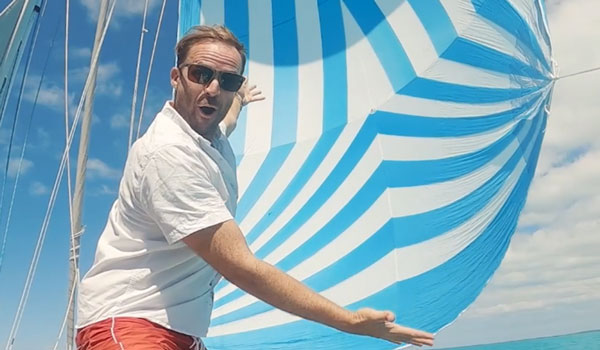
Sailing With a Spinnaker – Asymmetrical Basics (Gennakers and Light Air Sails)
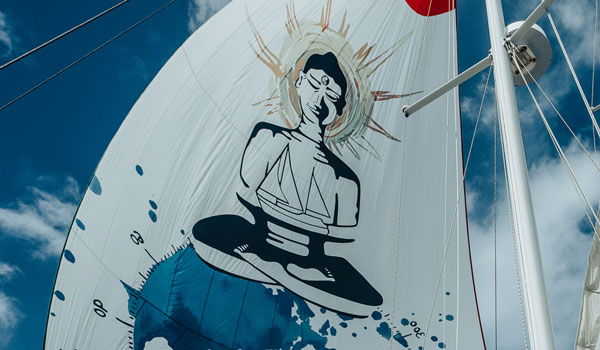
Sail Graphics, Colored Dacron and Color Customizations
Still confused.
Speak with a sail consultant and dial in your requirements for the perfect code zero.
" * " indicates required fields

- BUY A SAIL NOW
- WARRANTY POLICY
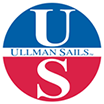
THE LANDING: BLOG
Cruising the code zero.
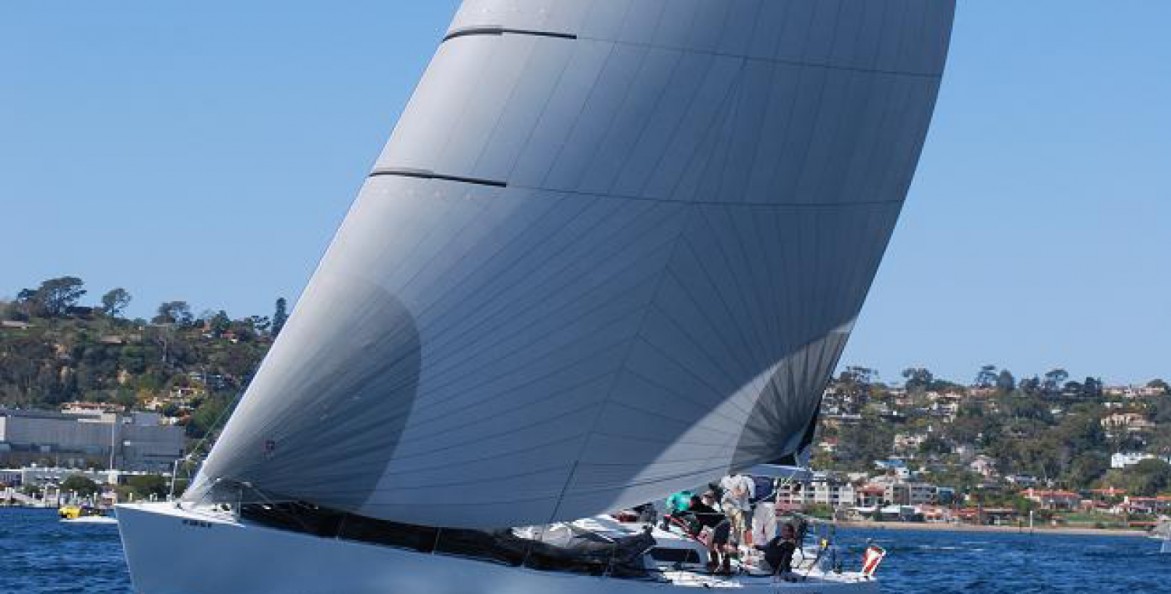
Chuck Skewes of Ullman Sails San Diego
By Chuck Skewes of Ullman Sails San Diego
Many sailors, especially cruisers, shy away from cruising the code zero, despite the sail’s versatility and ability to add significant increases in boat speed. In this article we remove some of the mystique around this specialty sail and explain how it can be used to enhance anyone’s sailing experience.
What exactly is a code zero?
Officially a code zero is a spinnaker for use in tight-reaching in light air – that’s it! The sail tends to be the smallest spinnaker in any sail inventory, whether racing or cruising. Racers have discovered that because of its size and applicable wind strength and angle ranges, the sail has benefits for racing performance while avoiding rating penalties. However, the practical applications of the sail apply just as much (if not more) to cruising boats.
The code zero was introduced in the 1997/98 Whitbread (now Volvo) Round the World Race. The event winners, Paul Cayard and the crew of ‘EF Language’, used a very small, tight-reaching spinnaker that could be used while the other teams could only use their genoas. It was very successful and since its introduction racers around the world have followed suit. The sail is considered a spinnaker instead of a genoa because of its dimensions. Sails built with a mid-girth length (the shortest distance between the leech mid-point and the luff) greater than or equal to 75% of the foot length qualify as spinnakers. The code zero meets this requirement. The mid-girth measurement is used in the rules to prevent teams from making 180% genoas and calling them spinnakers without the sail impacting their rating.
How does the sail cross-over for cruising?
Since cruising sails don’t have to meet any racing requirements we can actually make a much better sail for cruisers. The sail works like a very light, very large genoa. With a cruising code zero we can make the leech much straighter vertically, which allows us to make a straighter exit for the wind. This reduces heel and makes the sail more efficient and versatile. Essentially it provides more horsepower in light air, making sailing much more enjoyable. It is ideal for modern boats that have small non-overlapping headsails.
If someone occasionally races in beer-can races, can they use the cruising code zero to race?
A cruising code zero will rate as a genoa, so if it is larger than your largest genoa (and they always are!) you have to report it or not use it.
What wind ranges and wind angles do you use a cruising code zero in?
You can typically use a cruising code zero from 70° true wind angle (TWA) in very light air up to 110° TWA in 15+knts. Ultimately it depends on the righting moment of your boat and how comfortable you are with how much the sail may make your boat heel in significant breeze or at tighter angles. Most cruising code zeros are designed primarily for use in 85°-100°TWA.
How much extra performance should I expect to get out of a cruising code zero?
In light air the added speed generated from the sail is significant. It often more than doubles your sail area and can increase performance up to 30% as compared to a non-overlapping genoa.
If a code zero is for light wind, does that mean I’ll be motoring less? Do you use it for offshore cruising? Or would I use it in a harbor as well?
We use the code zero anytime the wind angle and wind strength are correct, whether we are in the harbor or on a long cruise. The light air performance will allow you to sail more and motor less, which, at least among our customers, we’ve found is typically the goal.
Are code zeros furling sails? Are they easy to launch? How many people do you need to do that?
Ullman Sails can design a code zero either as a furling sail or to launch from a sail bag. I recommend furling because you can set it up at the dock and easily roll and unroll the sail as the wind velocity and your angle change. Also, if you furl the sail, it can be used while single-handing. If you bag launch the sail you will want 3 or more crew on deck.
Have you had experience cruising with a code zero? Do you have a question we didn’t answer? What impact did it have on your sailing experience? Any advice you can offer to other sailors considering adding the sail to their inventory?
About Chuck Skewes A Seattle, Washington native, Chuck is an avid pro sailor and sailmaker. In just the last year Chuck has been part of the winning crews in the International Masters, Beneteau 36.7 West Coast Championships, and the Tjorn Runt in Sweden. He is also the loft manager at Ullman Sails San Diego and Ullman Sails Pacific Northwest. Chuck currently resides in San Diego and has been sailmaking since 1984.
- AROUND THE SAILING WORLD
- BOAT OF THE YEAR
- Email Newsletters
- Best Marine Electronics & Technology
- America’s Cup
- St. Petersburg
- Caribbean Championship
- Boating Safety

Code Zero Sails Help Build a Better Offshore Inventory
- By Jeff Thorpe and Rob MacMillan
- Updated: May 8, 2012
It’s one of those perfect offshore nights: solid wind, easy swell, clear sky, and sheets eased on a headsail reach. The on-watch crew is active on the sail trim and you’re making gains on your competitor to leeward. Fast-forward three hours into the watch. The navigator sticks his head up the companionway and asks, “What happened to the boat that was next to us?”
“Well, the breeze continued to build and went aft a bit,” you respond. “They were able to continue sailing their course, but we were struggling with speed and had to head up to maintain pace with this headsail.”
“Why is he able to sail that angle but we cannot,” counters the navigator. “We’ve been working him all night.”
“We think they did a sail change, maybe a kite,” is your answer. “With the increased breeze, we can’t carry our spinnaker at that angle. It’s too risky.”
“Damn. I wish we’d brought a reaching kite instead of only runners,” the navigator sullenly mumbles.
If a similar conversation has ever occurred on your boat, you’re not alone. Building the ideal sail inventory for a particular distance race is one of the most important aspects of your race preparation. The best way to ensure you have the right sail for the right conditions is to recognize any gaps in your inventory, gaps that, once filled, allow you to sail the best angle possible at all times.
The first step is to take a good look at your existing sail inventory , and then define the designed true windspeed and true-wind angles of these sails. Divide your inventory into three parts: upwind, downwind, and reaching. You probably have one main, three or four headsails that cover you in light, medium, and heavy conditions, and likewise for your downwind sails. It’s the reaching sails that are more difficult to fit into the inventory. You’ve got jib tops, reachers, Code Zero sails, and staysails as options, and it’s here in the reaching sails where you’ll most likely have the biggest gaps.
To give some insight into building a more versatile inventory, let’s explore a few commonly asked questions.

Courtesy of Quantum Sail Design
I need to improve my reaching inventory, but I am confused by the terminology and coding of some of the sails. Most sailmakers refer to odd numbered sails (A1, A3, A5) as reaching spinnakers and even numbered sails (A2, A4, A6) as downwind-orientated sails. Code Zero sails are most effective between 80 to 125 degrees true-wind angle, in windspeeds of 5 to 18 knots. However, it’s important to remember that the Code Zero is measured as a spinnaker. You can push these sails to slightly tighter angles in light winds, but be prepared for leech flapping. An A7 is a very small sail for very big breeze, 28 knots or more. It’s typically a fractional sail. A jib top is a high-clewed headsail used for tight beam reaching.
My boat came with a typical upwind sail inventory, but my crew insists we could use a Code Zero, especially if the race turns into an upwind drifter; is this true? A common misconception is that a Code Zero can be used upwind in place of a genoa. In perfect conditions—light-wind, smooth water—a true-wind angle of 70 to 80 degrees is about as close to the wind as you’re going to get from a Code Zero. On a masthead-rigged boat with 155-percent overlapping genoas, the gap that exists between a large jib top and an A5 reaching spinnaker is not significant enough to warrant a Code Zero. On a fractional-rig boat with non-overlapping jibs, however, a Code Zero is a necessary sail because of the significant gap between the smaller non-overlapping jib and the A5 reaching spinnaker.
For a long downwind race where I may need the same sail for extended periods, how do I make sure I have redundancy in the sweet spot of my asymmetric inventory? For Transpac, and many other coastal and offshore races, the A2 spinnaker is your workhorse. But the A2 you use for inshore buoy races to sail at low angles may not be the best sail for offshore racing, when surfing waves and dealing with shorthanded sail changes. For the Reichel/Pugh 45 Criminal Mischief , we developed an A2.5, which is essentially the same size as an A2, but is much more durable. It has more reinforcement, a flatter luff, a twisted leech profile, and an oversized tack patch. This kite bridges that important gap between the A2 for flatter seas and lower angles and the smaller A4 for higher winds. This allows us to drive the boat harder in those crossover conditions, when we need to be able to put the bow up to track waves and not risk a wipeout due to the size and fullness of the inshore A2. This also allows us to sail with two A2s (A2 & A2.5) that are each efficient in a given wind range. If we break one, we still have one with which to finish the race.
I race a Beneteau 44.7 in local PHRF events. The boat has a racing main, a 145-percent genoa, a 100-percent jib, and an all-purpose spinnaker. I’m planning to do the Bermuda Race but have a limited budget. What essential sails would you recommend I add to my inventory? A 145-percent jib top, heavy genoa staysail, and reaching spinnaker would be the primary sails to focus on. There can be a fair bit of reaching in the Bermuda Race and the jib top is a potent weapon for true-wind angles between 50 to 110 degrees. The jib top offers considerably better performance in this range because the design is orientated to reaching. It also makes the boat easier to drive and more balanced, especially when paired with a genoa staysail. The genoa staysail is an extremely versatile sail that can be flown inside of headsails and spinnakers; in a seaway it can help settle the boat into balance. You should also have a spinnaker for tighter reaching angles of 100 to 145 degrees, and for better control when sailing downwind in high wind speeds. This sail will be significantly flatter than your AP spinnaker and should be made of 1.5-ounce cloth.
I’m racing my Baltic 37 in the Pacific Cup and I have three full-size symmetric kites. My boat has problems tight reaching, and we have control problems downwind in anything above 18 knots. Is there a sail that can help alleviate these problems? Because your boat is a heavier IOR-influenced design with a masthead rig and overlapping genoas, I would eliminate the symmetric spinnakers. Asymmetric spinnakers are more versatile and user-friendly offshore, especially in surfing conditions when the acceleration brings the apparent wind forward. I would first add an A3 or A5 reacher, which can also serve as a heavy-air running kite to 150 degrees, and a light-air reaching kite, which you can carry as high as 90 degrees true-wind angle. Its primary intended range is the transition zone between your jib top and your full-sized spinnakers.
An A2 or A4 runner would have the same sail area as your biggest symmetric spinnaker, but provide a better option to bridge the gap between 130 degrees and 160 degrees true-wind angle. This would also provide better control running downwind in the 16- to 24-knot range with waves. Above this range you’re back to the A5, with the reduced girths and smaller sail area to allow you to sail a bit higher true-wind angle to maintain a user-friendly groove to drive the boat around in the waves.
- More: Boatspeed , Offshore Racing , Sailing How To , Sails
- More How To

The Wisdom of Augie Diaz

Why S-Turns, Roll Jibes and Roll Tacks Are Fast

The Path to Consistent Boatspeed

Headsail Trim Tips For Floating Leads

Brauer Sails into Hearts, Minds and History

Anticipation and Temptation

America’s Offshore Couple

Jobson All-Star Juniors 2024: The Fast Generation

- Digital Edition
- Customer Service
- Privacy Policy
- Cruising World
- Sailing World
- Salt Water Sportsman
- Sport Fishing
- Wakeboarding
- andrewmorrisey
- Apr 4, 2021
What type of Asymmetrical Spinnaker? Code Zero vs Code D.
Decisions – Decisions --- Code Zero or Code D?
What will be a better down-wind sail for our new Elba45 for our initial adventure coming down the coast of France-Spain-Portugal on the Atlantic side and then cruising in Mediterranean Sea next summer (2022)? What would be a better Asymmetrical Spinnaker, the Code Zero or Code D?
Both kites are on a roller furler which makes it much easier to douse, especially when a squall comes out of no-where. I do not think we will need a full Symmetrical Spinnaker until we do the Atlantic crossing. Looking forward to your comments and opinions on this one.
The Code Zero
The Code Zero is a cross between a genoa and an asymmetrical spinnaker that is used for sailing close to the wind in light air. Code Zero was initially an attempt to circumvent a rating rule by making a large genoa for close reaching on boats that were measured with non-overlapping genoas. The Code Zero got around the rule by measuring in as a very narrow-flat spinnaker with shape similar to a reaching genoa. Cruising sailors have a lot more options on the size and shape of a "code" sail.
The code zero is very flat and is designed for close reaching. It has a nearly straight luff, a mid girth about 60-65% of the sail's foot length. This sail is closer in shape to a traditional drifter than a spinnaker.

Cruising Code Zero (left) and a Cruising Spinnaker (right). The Code Zero is a much flatter "triangular" shaped sail that is designed for close reaching. The Cruising Spinnaker is bigger and rounder and designed for broad reaching.
The Code zero runs wind angles from 50-110 degrees.
The Code D is a cruising spinnaker with a nearly straight luff that furls from the bottom up, just like a genoa. ... Most Sailmakers has succeeded in developing an asymmetrical spinnaker that performs well from 80-degrees apparent wind angle to nearly dead downwind. With a regular, continuous line furler, it’s easier to use than a Stasher system and less expensive than top-down furlers. The Code D gets its name because its shape, a straight luff and round leech, makes it look like the letter "D."
It’s polar range is wide and can sail from 60 degrees to 140 degrees. If you have a spinnaker pole on the down-wind clew it can be pushed out to accommodate full dead down-wind angles of 180 degrees.

The comparison
-Upwind to apparent wind of 50 degrees
-Reaching to apparent wind of 110
-Apparent wind speed: 1-16 knots
-Approximately 60% of the sail area of a full-size spinnaker and about twice the size of a non-overlapping genoa.
-Upwind to apparent wind of 60 degrees
-Reaching to apparent wind of 140 degrees
-Apparent wind speeds: 1-16 knots
- Approximately 70% of the sail area of a full-size symmetrical spinnaker

After reviewing all the details we have decided to order a Code D and will let you know next year what we think. Note that on our J30 in Canada we have a APR 70 Asymmetrical Spinnaker in addition to a full Symmetrical spinnaker.

Recent Posts
It is now official - our new boat has been registered and licensed with the name 45North.
A taste of the cruising life in our own back yard
What to do when you have a floating home in the Mediterranean Sea? sv Makin Waves to-do list.
BoatNews.com
Code 0, the light and powerful sail for sailing close to the wind
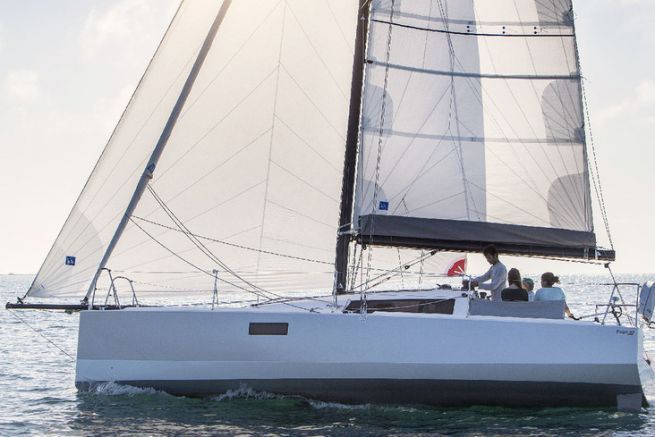
While summer and high pressure are installed on your navigation basin, you dream of a few extra knots to move your sailboat. Code Zero then becomes your best friend with its few extra square meters to get you moving.
Where does this Code 0? come from?
It seems that this terminology was coined during the 1998-99 Whitbread to define a flying canopy to be used upwind. There were already Codes 1, 2, 3... for sailing from full throttle to close hauled. The term Code 0 was coined to define a sail capable of sailing at tighter angles than any other flying sail . Over the last two decades, the evolution of materials and designs has made it possible to create very specialized sails for light airs.
A large, light, free edged genoa
The Code 0 is a kind of large, very light genoa that can be sent in the manner of an asymmetrical spinnaker or as a gennaker. This sail allows to tighten the wind in very light winds. With blocked materials such as laminated fibres and a fairly flat design you will almost be able to sail upwind. On the other hand, a slightly flexible fabric and a hollow shape will not allow you to sail upwind beyond 80°.
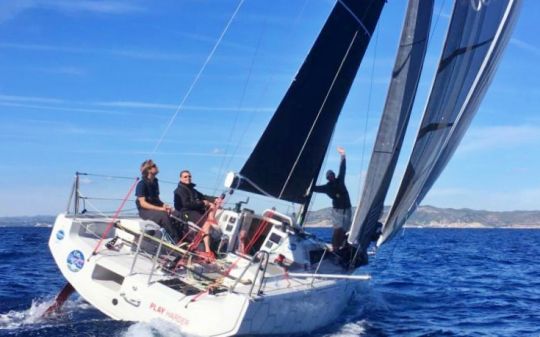
Who is the Code 0? for?
When the calm settles in, this sail is particularly useful on racing boats without a motor. However, it is gradually gaining ground on cruising yachts , which sometimes suffer from overweight and low overlapping headsails. Code 0 with furlers is becoming a relevant solution for increasing sail area in light airs.
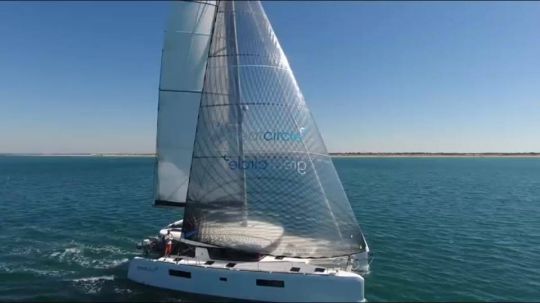
In regattas, can we use the 0? Code?
If you are a handicapped regatta sailor (IRC ORC...), you will be tempted to take such a sail on board. However, be careful with the measurements, otherwise your sail could be considered as a genoa , which would significantly increase the handicap of the boat . In IRC, the sail must be at least 75% of the edge at 50% of its height, in other words the shape is closer to an asymmetric spinnaker than to a genoa .
Can we turn around with a Code 0??
Tacking is not really the strong point of this sail , which will be more willing to gybe. However, if you wish to tack with Code 0, you will have to furl it in a large part before changing tack.
What are the criteria of qualité??
To be effective, the fabric should be "blocked" as much as possible with laminated materials. A nylon sail , such as a spinnaker , will only have a small range of use. In fact, when tacking to get closer to the wind, the leech will recede until it closes, which will then dump its wind into the mainsail ... all this is not very effective.
If you are using a furling system, the quality of the anti-twist luff rope is essential to roll the sail in all circumstances. The price of the rope is often directly related to its anti-twist properties. Some manufacturers such as All Purpose have developed Codes 0 that integrate the anti-torsion effect into their structure. This solution has already been validated on many racing boats and could soon win the pleasure boating market.
Can we keep the Code 0 in the mail and enroulé??
A Code 0 wrapped around its cable is a sail that will be quickly unfurled or stowed away. This equipment is not designed to stay in place full time. Although it is possible to keep it rigged for a few moments, it should be lowered as soon as the wind conditions cool down.
Spinnaker, Gennaker or Code Zero – Which sail suits which course?
Sailing downwind we will have something completily different then sailing upwind. In the moment we entered the situation to bear away, it is like we stopped watching one movie and started with another one. This is how Tihana Tadinac, experienced regatta sailor and key account manager at Bavaria Yachts, describes when you change course after sailing high upwind and want to sail downwind. And which sail is the right sail for the downwind course? Tihana explains the differences between spinnaker, gennaker and code0.

Which sail is the right headsail for sailing with the wind?
Downwind with the spinnaker
If your boat is equipped with spinnaker equipment, you will have a perfect downwind angle. With a spinnaker you can easily sail with a wind angle of 180 degrees. So that the wind comes directly from the stern. However, directly in front of the wind, the wind speed and the speed the boat makes through the water cancel each other out. If 10 knots wind speed blows and you have a boat speed of 4 knots, the true wind is only 6 knots strong. If you change course to a wind angle of 160 degrees instead of 180 degrees, the wind vectors change. Wind speed and boat speed do not cancel each other out as much. So the boat sails faster. If the target is directly in front of the wind, it can be faster to cross in front of the wind and to jibe more often. There are different designs for spinnakers. Of course there are many different sail designs for spinnakers. Flat cuts with which you can sail higher in the wind. Full and bulbous designs for more power before the wind. Spinnaker made of light cloth for low wind, and heavy cloth for more wind. Genrell you can say that the perfect wind angle for a spinnaker is between 180 and 130 degrees wind angle.

Tips for sailing with the spinnaker
Take care of the trim
Spinnaker pole with windward sheet must always be in 90 degrees on the telltale hanging on your shroud. If you don´t have your telltale on the shroud, then put one. If you don´t put one, then you can use wind arrow on your top mast. If you don´t have even an arrow, then you should have always spinnaker pole in the extensenion of the main boom (same direction lining). Main point of trimming the spinnaker is „to let him flow“ all the time while windward upper shoulder is slightly clapping, but not overlapping. If wind is gaining it is important to fix spinnaker with both sheets as closest to the front stay. You will be able to keep the boat steady with high waves like that.

Go fast with the gennaker
On downwind courses, you can always use gennaker too. You will need to do more gybes, but there is good chance that you will catch boats with spinnaker if you will compensate longer way caused by higher angle with higher speed. This is called Optimum Gennaker Speed. So, what we can say is main difference between Spinnaker and Gennaker:
- Spinnaker is Simmetric. That´s why Spinnaker has 1 halyard top and 2 simmetric edges (winward sheet with spinnaker boom and leeward sheet) – no fixed point.
- Gennaker is Asymetric and has 3 different points. The tack fixed point on the bow, or better solution fixed bowsprit. There is only 1 clew for both sheets on one place. An of course, the head as halyard point.
- Due to this Asymmetric design, Gennaker can drive only with sharper angels and not possible to bear away like with Spinnaker. That is why Gennaker is perfect for offshore when you have winds in direction from 90 to 140 degrees.

Tips for sailing with the gennaker
But what is the main difference between gennaker and spinnaker:
The spinnaker has a symmetrical design. The spinnaker halyard at the head of the sail, the afterhaul upwind on the spinnaker pole, and the sheet downwind on the clew.
A gennaker is cut asymmetrically. The neck on the luff is firmly attached to the bow, or better yet, to the bowsprit, the two sheets to the clew, and clearly the halyard to the head. Due to its asymmetrical design, you can sail higher upwind with gennaker than with a spinnaker, although the sail area is almost the same. However, also not as low downwind as with a spinnaker. The gennaker is perfect for long space courses with a wind angle in medium winds between 90 and 140 degrees. If the wind freshens up, you can drop down to a wind angle of 165 degrees with a gennaker. By the way, with a recovery hose, setting and recovering a gennaker is very easy and safe for any cruising sailor and professional with a small crew.
Secret weapon code zero
If you are entering in the position which is slightly lower then maximum up‐wind course, light(er) conditions, too high to gain optimum speed for Gennaker, then is perfect moment for Code Zero. For Code Zero, we can say is even 1 step easier to use then Gennaker. Code Zero comes usually with the whole system with small removable furler attached to Code Zero (as fixed part of the Code Zero). The attachment is the same as for the Gennaker. The furler is usually with removable system with elastic rope that you can attach on any place on stern that you find hard enough to holdout the force and to be clear from all other systems. It is very easy to hoist and to store. Usually it is made to hold even a bit stronger conditions. It is great sail that can compensate Genoa, but not Gennaker. With Code Zero, you are in position to achieve much more speed in lower angels then with Genoa / Jib. The maximum wind angle for a Code 0 is approximately 120 degrees wind angle.

Tips for sailing with the Code Zero
Our conclusion
So the choice of headsail on half-wind courses, space sheets or downwind courses depends on the course. Which sail you then really choose also depends a bit on the experience of the crew, the number of people on board and the area of use. For cruising sailing, the gennaker and code 0 are certainly easier to handle. If you are a sailor who is a bit more confident and have at least three people on board, you will have a lot of fun sailing a spinnaker. Any sailmaker will certainly be happy to advise you.
Latest Blog Posts
06.03.2024 Seasickness - information, prevention and tips
17.02.2024 All aboard: Going sailing with children. What needs to be considered?
27.04.2023 Buoy instead of anchor: correct approach and buoy check
- BOAT OF THE YEAR
- Newsletters
- Sailboat Reviews
- Boating Safety
- Sailing Totem
- Charter Resources
- Destinations
- Galley Recipes
- Living Aboard
- Sails and Rigging
- Maintenance
- Best Marine Electronics & Technology

Best Sails for Offshore Cruising: Understanding Code Zeros and AWA Reaching Sails
- By Mark Pillsbury
- May 31, 2022
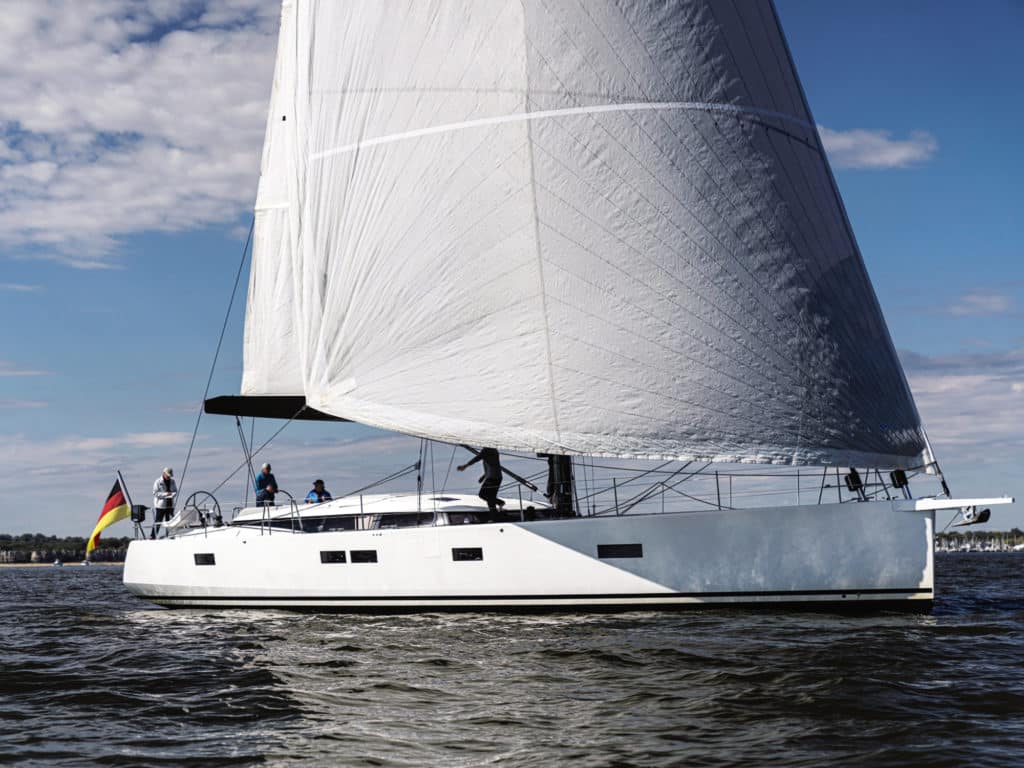
With 25 to 30 sailboats making their North American debut at the United States Sailboat Show in Annapolis, Maryland, each fall, it’s a logical place to look for design trends. Hard chines in the hull, galleys forward in the saloon, and grills and sinks incorporated into the transom are a few recent trends that multiple builders have adopted. But looking at this year’s fleet, what really jumped out at me was the number of boats being designed to fly self-tacking jibs.
By my count, 11 of the 27 new models in the Class of 2022 were rigged with roller-furling, non-overlapping headsails that get sheeted to a car mounted on an athwartships track on the deck, forward of the mast. Typically, the sail’s single sheet is then led to a block-located well up the mast, where it disappears into the spar, runs back down to the deck and, eventually, is led back to a winch, often located on the cabin top.
Add to those boats the majority of the rest of the fleet, which sported headsails measuring less than 110 percent of the foretriangle. Clearly, a revolution has taken place on the pointy end of most modern cruising sailboats.
Relatively modest-size mainsails and big, powerful genoas have been tossed overboard in favor of more horsepower in the main (often furled in the mast for ease of handling) and smaller, easier-to-control headsails that have dramatically reduced the effort needed to sail upwind. For those who haven’t tried, believe me, cranking in a 107 percent or smaller jib in a stiff breeze is a whole lot easier than grinding in the venerable 135 percent (or larger) genoa commonly found on older designs. And the self-tackers, well, once they and the main are sheeted home, coming about requires only a turn of the wheel.
UK Sailmakers International general manager Adam Loory says that there are obvious benefits for a couple or shorthanded crew: “It’s a smaller sail and it can self-tack, so one person on the helm can turn the boat; the jib moves over to the other side, the main moves over to the other side, and the other person can go on reading a book or whatever they were doing.”
But, he adds, “when you trade for the ease of handling a self-tacking jib, you lose all ability to sail on a reach, because on a tall, high-aspect jib, as soon as you ease the sheet, the top of the sail opens up and luffs, plus you don’t have the overlap to bend the wind around to the mainsail. And that’s the whole reason why all the owners of these modern boats are buying code zeros, because you need that sail to reach with.”
So, you ask: What is a code zero, and what happened to the genoas that once ruled supreme on the foredeck?
Well, it all started at the very top of the sport, where racing sails evolved thanks to changing measurement rules, and where equipment-makers are continually developing better sail-handling systems for long ocean races.
While most of us might get by quite well all season with a single headsail, say, a 135 or 150 genoa set on a roller furler, racers tend to favor a quiver of sails that can be swapped out as conditions and points of sail change. Depending on the regatta, they might carry a blade jib for tacking upwind, a close-reaching sail, a deep-reaching sail, storm sails, and probably a spinnaker or two for running. Setting and dousing all these sails is work, so hardware manufacturers came up with new gear that can furl the big billowing sails from the bottom up or, better yet, from the top down. These sails need to be set in front of the furled jib so that they are flown off a bowsprit, and thanks to the furlers, they can be left up when not in use.
In competitive sailing, sailmaking involves finding ways to develop new sails to take advantage of the various handicapping and measurement rules, some of which began to penalize the use of large, overlapping genoas. As a result, a hybrid sail, called the code zero, was designed so it would be measured as a spinnaker but still provide the reaching power of a big genoa. With all the code numbers already taken, this big, flat-cut, light-air reaching sail fell in at the low end—hence the name code zero.
At the same time, the trend toward smaller jibs for racing hard on the wind also meant sheets could be led at tighter angles. Since the sails no longer wrapped around outside the shrouds, the rigging could be moved to outboard chainplates, which lessened compression loads on the mast. That change allowed spars to be built lighter, reducing weight aloft, where it detracts from performance.
It’s worth noting that all of this was happening as builders searched for ways to make sailing simpler and easier, to keep sailors sailing longer, and to attract newcomers to the sport. With electric winches and in-mast and in-boom furling, larger mainsails can be readily tamed. And with smaller headsails, loads are reduced on sheets, which must be frequently trimmed.
The downside is that the minute many contemporary sailboats bear off, even a little, the sailing becomes, well, boring. The small jib quickly loses its oomph.
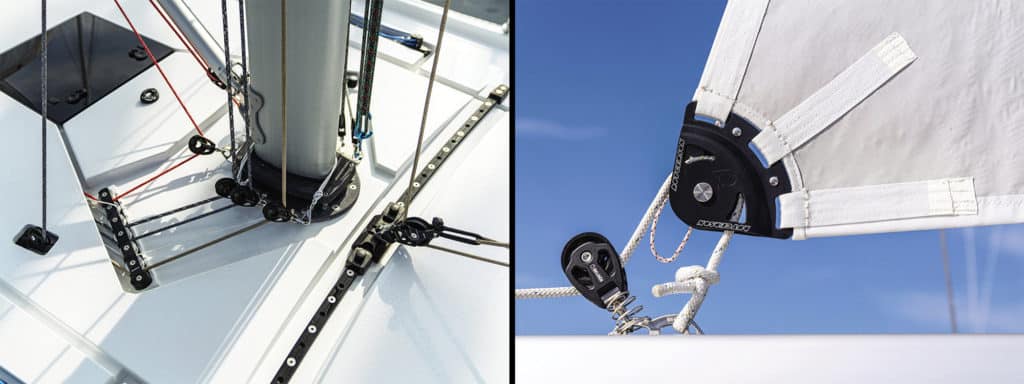
But fret not. In practical terms, the sails and gear developed to help racers have gone mainstream, and are now incorporated in many of the new production boats that might never see a regatta. The racer’s sprit and cruiser’s anchor bow roller have melded, so adding a furled code zero or cruising chute to, say, a Dufour 470 or Jeanneau Yachts 60 requires only a chat with a sailmaker.
And they, of course, are ready to talk details. Charlie Saville at Quantum Sails in Annapolis says that manufacturers, for the most part, have left the question of additional sails to the buyer. “The OEMs point people to us and say, ‘Talk to your sailmaker because they’ll help you figure out size and material.’”
Quantum offers three versions of its apparent-wind angle reaching sails: the AWA 40 (light air upwind and close reaching), AWA 60 (close and midrange reaching) and AWA 80 (beam to broad reaching).
While a racing skipper with a healthy budget might choose to carry all three because each is optimized for a certain point of sail, most cruisers won’t. That’s where a consultation with the sailmaker comes in. They’ll ask where you intend to sail and what sort of crew you’ll have, and then walk you through the choices.
“If you’re going to have one reaching sail, pick which one you think you’ll be doing the most of, and choose that one,” Saville says.
Loory says that selecting the right reaching sail depends on the boat and how much power is needed for it to sail properly, given the conditions. A code zero for a boat sailing in typically light airs on Chesapeake Bay or the west coast of Florida would be very different than one spec’d out for a sailboat bound for the Caribbean or expecting to sail summers on windy San Francisco Bay.
“That’s why it’s really important that the sailor works with the sailmaker to explain how they’ll use the boat, what kind of boat it is, who’s sailing the boat, and where they’re going with it,” he says.
Cruisers sailing older boats might make out just fine poling out their 135 or 150 percent genoa when sailing dead downwind, but owners of the more-modern designs should also consider carrying a cruising asymmetrical spinnaker, either on a furler or with a dousing sock, if they plan to rely mostly on wind power to get from here to there. Again, Loory says, the chute can be designed for anticipated conditions.
Cost estimates vary depending on the boat, the sailor and the material, but expect to pay in the $4,000 to $5,000 range for a code zero built for a 40-footer. Add another $3,000 and change for a furler and anti-torsion cable.
Gennaker is the name that North Sails uses for its reaching sails, says Will Welles, a sailmaker in the company’s Rhode Island loft. North recently introduced a couple of designs, each built with a structured luff so that a smaller anti-torsion cable can be used. The cable runs between the swivel that’s attached to the halyard and the continuous line furler, and the sail furls around it when not in use.
The Helix Furling Gennaker is intended for light air and tighter wind angles, while the Easy Gennaker is a fuller-cut sail optimized for deeper angles.
The Helix is designed for a wind range from about 5 to 16 knots. The lighter the breeze, the higher you can sail, Welles says. As the wind builds, you can put the bow down and sail deeper. How deep and when to furl or snuff the sail depends on the comfort level of the crew.
The Easy Gennaker covers essentially the same windspeed range but is meant for more broad-reaching conditions. An owner who wants to carry both sails might consider having a swivel and anti-torsion cable for each sail but using the same endless line-furling drum to save a few dollars.
But, he notes, “most cruisers are cruising, out on the water relaxing and enjoying themselves. They typically don’t have a foredeck team, thus one sail that can cover a large range is preferable. They might choose a Helix Gennaker because it’s just a more versatile sail. You can probably get as low as 135 apparent with that sail by easing the halyard. It’s not going to perform as well as the Easy Gennaker at the broader angles because it’s a much flatter shape and it’s a smaller sail in the midgirth, but it’ll work, and it would certainly be better than trying to sail downwind with a self-tacking jib.”
Mark Pillsbury is a CW editor-at-large.
Furling reaching sails, whether called a code zero or gennaker, can be built with ultraviolet protection, though the covering is lighter in weight than the layer of Sunbrella or other material that might be used on a jib or genoa designed to be stowed for long periods of time on a conventional rigid furler. Because the code zeros are intended to be flown in lighter breezes, to avoid sagging, a lighter cover is used, and it’s glued on rather than stitched.
All three sailmakers said that the reaching sails can safely be left up for a weekend or typical short cruise but should be taken down and stowed below when the boat is put away, or if it’s going to be at anchor for any length of time.
In the case of boats with a solent or cutter rig, where a non-overlapping jib is set on the inner forestay and a code zero is furled on a traditional rigid furler on the forward stay, a heavier cover can be applied.
Contact a Sailmaker
- Doyle Sailmakers: 978-740-5950, doylesails.com
- Neil Pryde Sails: 203-375-2626, neilprydesails.com
- North Sails: 401-683-7997, northsails.com
- Quantum Sails: 231-941-1222, quantumsails.com
- UK Sailmakers: 914-600-8800, uksailmakers.com
- Ullman Sails: 27-21-007-3826, ullmansails.com
- More: Gear , Hands-On Sailor , print 2022 may , sails and rigging

C-Map Updates North America Charts

Setting Course for a More Sustainable Future
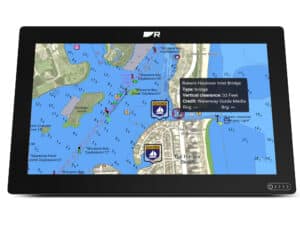
Raymarine Expands LightHouse Charts
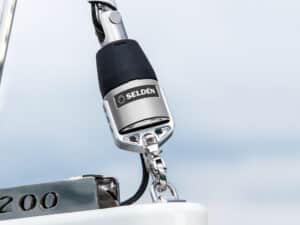
Push-Button Convenience

Kirsten Neuschäfer Receives CCA Blue Water Medal

2024 Regata del Sol al Sol Registration Closing Soon

US Sailing Honors Bob Johnstone

Bitter End Expands Watersports Program
- Digital Edition
- Customer Service
- Privacy Policy
- Email Newsletters
- Cruising World
- Sailing World
- Salt Water Sportsman
- Sport Fishing
- Wakeboarding

images of this ship

Description
Launched in September 2020, luxurious Sunreef 60 sailing catamaran CALMA offers 225 m² of living space to enjoy life on board. CALMA's layout features five exclusive double ensuite cabins for ten guests, a stylish saloon with cosy lounging and dining areas, and a functional galley up, giving the chance to watch a professional chef in action. Thanks to the sliding saloon door the interior blends naturally with the outside, opening onto the large, sheltered aft deck and the splendid front terrace. The spacious flybridge features a BBQ, a wet bar and plenty of seating for enjoying the beautiful panoramic views. Operated by an experienced crew of 3, this grey-hulled beauty is available in the Caribbean in winter and in the Balearics in summer.
Accommodation
1 x Master Cabin 4 x Guests Cabins
Specifications
BBQ onboard:
Cruise Speed (knots) :
Sunreef Yachts
AB with yamaha 70 HP
Consumption Units:
• Engines: 2 x Volvo D3 150 HP - • Generator: Kohler 22.5 KVA, 50Hz, 230V
Fishing Gear:
Snorkle onboard:
Kiteboarding:
Yacht Range:
Sea Scooter:
Paddle Boards:
Wake Board:
Wind Surfing:
Water skiing:
Scuba onboard:
Ready to set sail?
Summer Areas
W. Med - Spain/Balearics, Mediterranean & EU
Winter Areas
Weekly Rate from:

View more... >

Service Excellence

Total Flexibility

Captain Owned

Lizette Cabeza

Let's set sail!
Ready to start your journey on a Luxury Yacht Vacation? Check availability and arrange your itinerary with us today:

- Yachting World
- Digital Edition

How to choose the right asymmetric spinnaker for your kind of racing
- October 19, 2015
The asymmetric spinnaker or A-sail has helped to simplify downwind sailing, but picking the right one can be the hard bit – there’s just so much choice. Jonty Sherwill investigates the options

© ROLEX/Daniel Forster
What should you be looking for in an A-sail for your boat when the bulk of your season’s racing is a mix of inshore racing round the cans and windward-leeward racing with the occasional offshore event thrown in?
It’s easy to assume than an A-sail – or asymmetric spinnaker – is a fairly standard ‘all-purpose’ piece of kit on a modern yacht, but these sails have come a long way since the early days of cruising chutes and flat reaching sails that were sometimes added to a conventional spinnaker inventory. Today on many racing boats A-sails have usurped the symmetrical kite as the mainstay of a downwind sail inventory.
Neil Mackley of North Sails UK has been at the leading edge of this evolution and explains why knowing the characteristics of the boat is so important: “We look at the boat’s VPP and find out the ideal angles the boat sails at in a given wind speed to determine the size and shape of sail required – it will be a quite different design for a TP52 sailing fast with apparent wind forward using flatter asymmetrics compared with a heavy-displacement Swan 60 running at 170° T.”
Although setting the right sail is important to make you fast downwind it’s clear that sailing technique and knowing your target boat speeds is also a big part of it. “An example is the J/109 which, in 8-10 knots, will be searching for VMG at 135°-140° true with a flatter-luffed A1 sail. With a bit more pressure they will head down to 145°-150° true wind angle using a fuller A2 sail that projects the shoulders. When the wind reaches 18-19 knots it will be time to go bow up again and surf,” says Mackley.
Having established the performance profile of the boat, the sailmaker needs to know what type of offshore racing you are planning to do. Will it be an occasional JOG race, a fully crewed RORC campaign, or maybe a double-handed Fastnet Race?

It soon becomes clear that to provide good performance across the full wind range for both reaching and running just setting one A-sail will not cut it in a competitive fleet.
While a typical inventory will usually consist of three A-sails, often including a Code 0 for close reaching, it’s not uncommon to see four or even five asymmetric spinnakers being carried, particularly on the larger yachts.
Under IRC the rating ‘tax’ for these extra sails is reduced as the boat gets larger, typically two points extra per sail over 35ft LOA – but check with the Rating Office.
Code 0 a ‘given’
Peter Kay of One Sails thinks that for a mixed programme of inshore and offshore races the Code 0 is almost a given in a three-sail inventory, alongside an A2 light-medium runner plus a 0.9oz A4 that would run in almost any conditions: “If the racing is to be all inshore you might substitute an A3 reacher or a second A2 for the Code 0 depending on budget.”

A further option is the wide range of Nylon spinnaker fabrics now available. With ten weights of fabric from 0.4 to 3.0 ounces, this allows the sail designer to fine-tune designs for a specific boat’s performance profile and, just like an inventory of headsails, each A-sail will have a ‘sweet spot’ for wind speed and apparent wind angle.
Another factor to be considered is whether the boat is fitted with a bowsprit or uses a conventional spinnaker pole. The latter has the advantage of being able to go ‘pole back’ for running square, but it makes gybing more complicated, requiring the tack of the sail to be swapped to a bow tackle and then back onto the pole after each gybe, which is likely to lose you a couple of boatlengths each time.
For offshore racing with less frequent gybes that may not be such a big issue, but when racing windward-leeward courses or round the cans, where regular tactical gybes will be needed, the activity on deck will also telegraph your tactics to the fleet. “That’s in contrast to a symmetrical spinnaker boat that can float through a gybe at a moment’s notice [at least in light airs],” explains Neil Mackley.
The difference is less marked with bowsprit-equipped boats, but at the top end of the wind range the boat handling advantage swings to the asymmetric boats. Even so, the art of achieving the ‘late main gybe’ (where the kite is fully gybed before the mainsail comes across) needs to be practised to avoid what could be a costly broach.
Mackley continues: “A-sails are really good for long legs without gybes and in point-to-point races. On a boat like the Swan 45 with a spinnaker pole our tests have shown that an A2 sail is a faster sail than the equivalent symmetrical S2 with better attached air flow and the narrower head angle which reduces roll.”
Campbell Field, professional navigator and offshore team manager, explains further: “When looking at inventories of A-sails for inshore v offshore racing, one has to consider very carefully the two modes of sailing. Inshore racing is typically VMG-oriented, with a set of trimmers or grinders who can give 100 per cent for a few hours, in moderate to flat seas. Offshore or coastal racing is more varied, much longer legs, so normally sailing a ‘hot’ VMG mode, with longer waves and swell to consider.
“As an example, for an A2 for inshore racing you would be looking for a big shouldered sail, well projected luff, with maximum area sail that requires 100 per cent trimmer and driver concentration to keep the boat in that very narrow max VMG groove.
“[By contrast] an offshore A2 has to be more versatile and forgiving, slightly smaller shoulders (but still max area), slightly straighter luff for a bigger ‘groove’ to allow the driver to sail around waves and absorb the apparent wind swinging from the boat’s acceleration and decelerations.
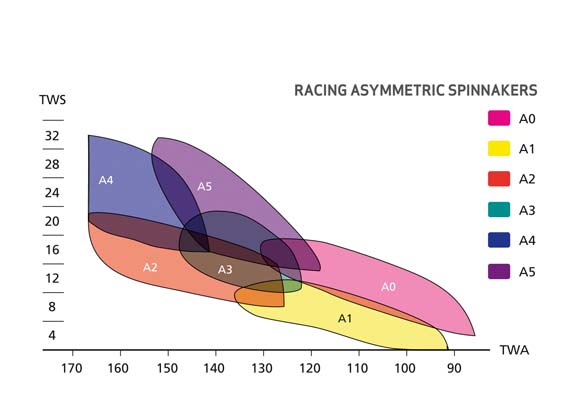
“This will also preserve some of your trimmers and grinders on the really long runs. A flatter shape would improve the ability to sail higher angles and increase the overlap to a reaching A3 – giving you a better chance of sailing the course you want to rather than the one dictated by the sail.”
With this advance of A-sail design a bowsprit appears to be the logical route on most boats, but how has the progression of the A-sail from a fast reaching sail to an effective deep running spinnaker been achieved?
“While early A-sails were designed the same way as symmetrical spinnakers, with shape in the radial head and a bit of shape in the middle and clews, now our design software means that every single panel has shape in it, so the sails have became smoother and easier to fly,” explains Mackley.
You might think that, with sophisticated sail design software creating predictable flying shapes, this would tend to standardise all sail designs, but it seems there is still plenty of scope for individual design philosophy. Peter Kay of One Sails says: “When running we are looking for maximum projected area so our approach is to shape the sail, particularly the upper leech, in a way that allows the sail to rotate around the forestay, out to windward and which will respond well to tweaker [downhaul] adjustment.”
The effect on your rating
An important consideration when changing things on your boat is the effect it will have on your rating. Some aspects of the A-sail revolution offer potential gains without any rating penalty, eg the Code 0, and the RORC has made sure that the IRC Rule has kept up with these fast-moving developments.

And what of those looking to change from a symmetrical spinnaker with sheets and guys? When upgrading an older boat to A-sails, one of the key decisions is whether to stick with the existing spinnaker pole, with the benefit of being able to ‘pole back’, or invest in fitting a bowsprit for slicker gybing.
While a retractable bowsprit has the advantage of less overall length in the marina it would probably be difficult to retrofit so an externally fixed bowsprit and bobstay is a more popular solution – this is a common sight now on boats of all sizes.
- Assess what type of sailing will form the bulk of your season – eg offshore, inshore, round the cans or windward-leeward.
- Get a polar performance chart for your boat to identify a baseline for performance.
- Bowsprit or spinnaker pole? The latter will allow you to square off deeper downwind, but is more complicated in hoists and gybes.
- Given a three-sail limit and a mix of inshore and offshore racing, many opt for Code 0, A2 light-medium runner and A4 runner.
- Inshore programmes might substitute an A3 reacher or a second A2 for the Code 0 depending on budget.
- Consider what would be the effect of a change to your rating.
See our 5-tips on racing with an asymmetric
Call Us: +44 121 285 8010
NEW VAAN R5 with el. engines, code-0 sail & fully recyclable being built in Holland!
Published by Eldin Basic on Feb 24th, 2022
As a VAAN Catamarans representative in the UK, we are pleased present VAAN R4 and R5. Builders of highest quality sailing catamarans with electric engines and by using fully recyclable materials 100%, the 42ft and 49ft catamarans are latest in tech, innovation and top quality shipyard multihulls available to purchase ...

First fully recyclable VAAN sailing catamaran was just launched late last year, in November 2021. It was a VAAN R4, the 42ft performance sailing cat available from 399,000 EUR. She can come with options such as foldable centreboards (150-190cm total draft) at a cost of 12,900 Eur, FSC cork decking in cockpit and transom (7,900 Eur) or on the upper deck (11,025 Eur). Other notable and recommendable extras for VAAN R4 (similar offering for NEW R5 as well) are electric furling system jib at 13,121 Eur, Quantum 85m2 Code-0 with furler at 11,625 Eur or 2x Harken electric winches on V-grinder at 7,090 Eur to name but a few.

VAAN R5 The VAAN R5 pricing starts at 895,000 Eur and a fully equipped boat can cost as high as 1,5 million Eur (including code-0 sail, upgraded el. Engines, generator, air con and many, many other extras, while a reasonably equipped blue ocean sailing boat is likely to be around 1,25 million... Delivery times are to be confirmed at the time of order. Most likely 10-12 months initial suggestion with a small refundable deposit of 5,000 - 8,000 Eur sufficient to secure your own slot. Let us just add that the Code Zero sail's definition is ''a cross between a genoa and an asymmetrical spinnaker that is used for sailing close to the wind in light air'' ... You won't be offered this as an optional extra on most other types of catamaran for a single reason as they can sail when reaching close to the wind or a flat sail with straight luff, a mid girth about 60-65% of the sail's foot length and designed to provide sailing speed when there is almost no wind won't take you places unless you sail on a VAAN CATAMARAN!
SPECIFICATIONS (subject to change)
- LOA: 49ft / 14.95m
- Beam: 7.94 m
- LWL: 14.39 cm
- Draft: 120 cm / 200 cm (retractable centerboard optional)
- Mast Height: 23.8 m
- Propulsion: 2x electric pods
- Bridge deck clearance 91 cm
- Sail areas:
- Main: 80 m2
- Jib: 45 m2 (self-tacking)
- Code-0: 120 m2 (option)
- Gennaker: 170 m2 (option)

How to buy: First, you are invited to arrange a visit to the shipyard and take a look at the existing models and make up your mind directly. In case you are interested to learn more or indeed to order a NEW VAAN R4 or R5 sailing catamaran, we can send you a quote with selected equipment which we recommend as essential or necessary for a private owner or we can just send you a general excel pricing for you to select any extras. With a small refundable deposit of around 5,000 Eur you can reserve your slot. We can also offer a fully managed solution with crew service, insurance, booking as central agency so as to reduce your ownership costs by providing some returns through charter income or we can advise on who to equip the boat based on your actual sailing area and for the private usage. Awaiting your feedback before sending a quote.
To book your luxury sailing catamaran charter in 2023 (no VAAN cats will be chartering before most likely) and on board of a NEW VAAN R5, or on one of the other yachts available for charter across the Mediterranean in 2022, on a lastminute dealsor advance bookings for next year, please do get in touch by filling out the enquiry form, by email, on WhatsApp or on social media.
This news refers to the NEW VAAN R5 sailing catamaran to be launched in Holland by end of 2021 or early 2022.
In case you are interested in chartering one of these or similar yachts or wish to consider purchasing one of the models which are offered for sale, do let us know by filling out the CHARTER REQUEST FORM or send us an email to [email protected] now.
Disclaimer: The information provided here are made as a general guide only, made to give a broad description and latest news of the shown yacht or yachts. They are not intended to constitute part of an offer or contract. The details of the luxury yacht or yachts displayed on this page are made merely for informational purposes, and the yacht or the yachts are not necessarily available for yacht charter or for sale, nor is she or they represented or marketed in anyway by SuperSailYachts.com. All details, including any photographs, measurements, plans and specifications mentioned, are given as a guide only and should not be relied upon for the purchase or charter of this yacht. The copyright of all details, photographs and deckplans remains the property of their rightful owners or their chosen representatives.
This news refers to:
Transatlantic crossing with a supercat 70ft sunreef catamaran this november.

Italian lifestyle at its best with Southern Wind 82 supersailyacht!

Looking to charter best Lagoon Seventy 7 there is? Look no further!

Superyacht charter on BENETTI VISION 145 with 20% discount in Greece!

NEW Lagoon 65 catamaran charters in the Balearic islands!

Sandy and Doug chartered a luxury ASTONDOA 105, a 31.5m super yacht in South of France. A meticulously planned charter went exceptionaly well and we even arranged for a JET SKI instructor to come on board so the clients could get their Jet Ski licences.
- Yacht Charter
- Destinations
- Giga yachts
- Super yachts
- Mega yachts
- Sailing yachts
- Power boats
- testimonials-17"> Testimonials
- Useful links
- Privacy Policy
- Legal Notices & Terms

Thank you, Your request has been sent!
Please fill up the form:
Charter Requests Form
Personal Info:
Please specify your request:

Catamaran Screecher / Code 0
Code 0 / screecher, code 0 specifications, code 0/screecher design process.
Catamaran type Code 0's are called Screechers and specially made for catamarans. Screechers are designed a little more flat than a code 0, due to the design of the Catamaran and their sails. Fareast sails Screechers are fully customized with your sailing style in mind. Screechers are radial cut for optimal performance. Each sail is assembled in an organized data sheet for you. You will then be able to review the chart and make changes. Once you approve the chart, we draw each sail and we provide you CAD drawing of your sail(s). You can again review and make changes. Once you approve the drawings, we cut your sail. The process is quite easy.
Screecher Design
Screechers are a hybrid between a spinnaker and genoa, tending more toward the headsail, it generates headsail-type. Screechers are made with premium sail cloth from Challenge, Contender, and dimension-polyant sail cloth for both inshore and/or offshore applications. Our Screechers Designs provide an excellent all-around performance sail. Screechers designs consist of both nylon and laminate cloths.
Depending upon the fabric and boat design, the Screechers can be carried from as close as 45 degrees apparent wind angle (AWA), to as wide as 75 to 110 degrees. Mid girth measurement 60-65% of the foot
Screechers can be also Optimized to 60 - 140 degrees apparent wind angle (AWA), Approximately 70-75% of the sail area of a full-size spinnaker. Mid girth measurement 75-85% of foot length.
- Our Screechers are CAD drawn and presented to you before production
- Screechers come with 4 color option standard (certain cloths have limited color choice)
- Every Code are designed with 3 step zig stitched (triple stitching) standard
- Options Include: Piston Hanks, Numbers, Torque Rope, and Colored logo designs
- Blue water finish for ocean passages
- Sails are full radial Design Standard
- Screechers can be designed for top down furler with Vectran or Polyester Torque Ropes built into the luff
Code 0 Cloth
- Body Challenge Sail Cloth: Fibermax (.75 oz and 1.5oz) , Elite Racing Nylon
- Contender Sail Cloth: Maxlite (1.5oz), Nylite (.90oz), Superlite, Superkote, Stormlite, Maxikot
- Dimension-Polyant – CZ Sliver, CZ GP, CZ White
Get In Touch
Request a quote for your sails or simply get in touch with the Far East Sails team.
Oldest canoes ever found in the Mediterranean Sea unearthed off the coast of Italy
The wooden vessels were likely used by Neolithic people for fishing and transport.

Five canoes found at the bottom of the Mediterranean Sea were used more than 7,000 years ago for fishing and transport by people living in a Neolithic village near what is now Rome.
Archaeologists discovered the boats off the coast of Italy at La Marmotta, a prehistoric coastal settlement that is now underwater, while conducting ongoing excavations, according to a study published Wednesday (March 20) in the journal PLOS One .
The large dugout canoes — which were constructed of alder, oak, poplar and European beech — were built between 5700 and 5100 B.C., radiocarbon dating revealed.
The boats are the oldest ever found in the Mediterranean, according to a statement.
"One of the smallest [boats] was probably used for fishing," study co-author Mario Mineo , an archaeologist and director coordinator at the Museum of Civilization in Rome, told Live Science in an email. "The two largest measured almost 11 meters long by 1.2 m wide [36 feet by 4 feet] and it is probable that — thanks also to the easy access to the Tyrrhenian coast via the Arrone river — they could have been used for further trade."
The boat builders also used "advanced construction techniques" to craft the vessels. For example, they incorporated transverse reinforcements, which would have increased the durability of the canoes' hulls, according to the statement.
Related: Dozens of Neolithic burials and 'sacrificed' urns and ax found in France
Sign up for the Live Science daily newsletter now
Get the world’s most fascinating discoveries delivered straight to your inbox.
"The construction techniques and materials used indicate a sophisticated understanding of boat-building and navigation," senior study author Niccolò Mazzucco , a senior researcher in the Department of Civilizations and Forms of Knowledge at the University of Pisa in Italy, told Live Science in an email. "[This] is significant because it showcases the ingenuity and skill of ancient peoples in utilizing natural resources to create efficient means of transportation."
For example, the researchers think the vessels may have been equipped with "sails or outriggers," or parallel support floats, Mazzucco said. This can be evidenced by three T-shaped wooden objects found at the site near the canoes. Each of these items contained various holes, which were likely used to "fasten ropes tied to sails or other nautical elements," according to the statement.
"Such advancements suggest a deeper comprehension of maritime technology and navigation, with vessels equipped for long-distance voyages," Mazzucco added. "However, our current understanding falls short of precisely identifying the types of boats used, their construction methods and how components like canoes and T-shaped wooden objects were mounted together — whether through ropes, wooden pegs or other means."
The builders' ability to include multiple types of wood in their creations is also noteworthy, as it shows that they knew which "trees could be used to make the dugouts," Mazzucco said. "In contrast, at other [Neolithic] sites where more than one canoe has been found, the same [tree] species was usually used for all of them."
— 'Astonishing' Neolithic burial containing a human, cattle and chariot discovered in Germany
— Chiseled obsidian recovered from Neolithic shipwreck near Capri's 'Blue Grotto'
— Elite Bronze Age tombs laden with gold and precious stones 'among the richest ever found in the Mediterranean'
In addition to the boats, archaeologists found numerous artifacts scattered around the site, including flint and obsidian tools, pottery vessels, figurines and ornaments, according to the study.
In 2022, the researchers also found 52 wooden sickles at the site that were used for harvesting cereal grains.
"These artifacts offer further insights into the daily lives, symbolic and technological capabilities of the ancient inhabitants," Mazzucco said. "No other site in the Mediterranean presents such [an] amount of harvesting tools."

Jennifer Nalewicki is a Salt Lake City-based journalist whose work has been featured in The New York Times, Smithsonian Magazine, Scientific American, Popular Mechanics and more. She covers several science topics from planet Earth to paleontology and archaeology to health and culture. Prior to freelancing, Jennifer held an Editor role at Time Inc. Jennifer has a bachelor's degree in Journalism from The University of Texas at Austin.
Obsidian blades with food traces reveal 1st settlers of Rapa Nui had regular contact with South Americans 1,000 years ago
'Astonishing' Neolithic burial containing a human, cattle and chariot discovered in Germany
2,000 earthquakes in 1 day off Canada coast suggest the ocean floor is ripping apart, scientists say
Most Popular
By Robert Lea March 21, 2024
By Jamie Carter March 21, 2024
By Jennifer Nalewicki March 20, 2024
By Kristina Killgrove March 20, 2024
By Anna Gora March 20, 2024
By Elise Poore March 20, 2024
By Patrick Pester March 20, 2024
By Drew Turney March 20, 2024
By Keumars Afifi-Sabet March 20, 2024
By Paul Sutter March 20, 2024
- 2 India's evolutionary past tied to huge migration 50,000 years ago and to now-extinct human relatives
- 3 Dying SpaceX rocket creates glowing, galaxy-like spiral in the middle of the Northern Lights
- 4 12 surprising facts about pi to chew on this Pi Day
- 5 1,900-year-old coins from Jewish revolt against the Romans discovered in the Judaen desert
- 2 Speck of light spotted by Hubble is one of the most enormous galaxies in the early universe, James Webb telescope reveals
- 3 8-hour intermittent fasting tied to 90% higher risk of cardiovascular death, early data hint
- 4 James Webb telescope confirms there is something seriously wrong with our understanding of the universe
- 5 Beluga whales appear to change the shape of their melon heads to communicate, scientists discover

IMAGES
VIDEO
COMMENTS
Catamarans and trimarans have notoriously small jibs, making them grossly underpowered in light breeze. A screecher is larger, higher clewed, and fuller than a genoa but flatter than a typical code zero. 3. A code zero is strictly a racing sail. Cruisers of all ilks have taken to the sail for its range and ease of use.
The sail can be used at relatively tight angles in light air, and at very broad angles in heavier air. "It will take you through more wind angles than any other sail on the boat. Your kite is for downwind, your genoa is for upwind; the Code 0 is for all the angles in between," Stewart says. Rob Greven of the Netherlands-based Spirit ...
We had high hopes for the Code Zero...the sail is an incredibly popular setup on newer boats. The idea of making good time with the sails instead of firing u...
A Code Zero has a mid girth of 75% of the foot length, so it measures as a spinnaker but has a much bigger area than a genoa. The optimal wind speed for this sail is 3 to 18 knots true wind speed and in lighter winds, you can carry this sail up to a 45-degree true wind angle. Typically they are designed to be flatter than a spinnaker and have a ...
You can typically use a cruising code zero from 70° true wind angle (TWA) in very light air up to 110° TWA in 15+knts. Ultimately it depends on the righting moment of your boat and how comfortable you are with how much the sail may make your boat heel in significant breeze or at tighter angles. Most cruising code zeros are designed primarily ...
A Code Zero is tacked ahead of the genoa - either on a sprit or on the anchor's bow roller. Furling sails require high tension to furl effectively, so if the sail sets on a sprit it must be well supported or very robust. Obviously the roller drum must clear the other genoa's furler drum. The head swivel attaches to the spinnaker halyard.
Onboard Sail Care: UV Protection - Inspecting Halyards & Lines. +. Choose your angle with Quantum's specialty line of high-performing, versatile, and easy to use code zero sails. To help clear up this somewhat confusing category, Quantum developed its line of reaching, code sails around the target Apparent Wind Angles (AWA).
Cruising Code Zero for overlapping boats. Optimized for boats with overlapping genoas. Apparent wind angle: 60°-140°. Apparent wind speed: 1-16 knots. Approximately 70-75% of the sail area of a full-size spinnaker. Mid girth measurement 75-85% of foot length. A reaching sail that compliments a cruising spinnaker.
The Quantum Code 0 for cruising monohull sailboats is a full sail, shaped like an asymmetrical spinnaker, and furls easily on a top-down furling system. While the midgirth of the racing Code 0 is restricted to at least 75% of the foot length, the cruising version of the sail has no restrictions, giving the sailmaker a lot of leeway in design.
After all, this is how we actually sail! In this video, David defines the parameters of a code zero and discusses the evolution of code sail designs. He dives into Quantum's line of AWA sails and discusses the different models - AWA 40, AWA 60, and AWA 80. Request a quote now or get in touch with one of our sail consultants if you still have ...
Code Zero sails are most effective between 80 to 125 degrees true-wind angle, in windspeeds of 5 to 18 knots. However, it's important to remember that the Code Zero is measured as a spinnaker ...
Our Code 0's are made with premium sail cloth from Challenge, Contender, and dimension-polyant sail cloth for both inshore and/or offshore applications. Our Code 0 Designs provide an excellent all-around performance sail. Code 0 designs consists of both nylon and laminate cloths. Code 0's can be also Optimized to 60 - 140 degrees apparent ...
If made with laminate Code 0 cloths or light Dacron, these sails can have a light-weight UV strip added, allowing them to be left furled on the bowsprit when not in use. ... David Calvert has been sailing and racing catamarans and trimarans for years and is the owner of Calvert Sailmakers LLC, which specializes in building sails for multihulls ...
It has a nearly straight luff, a mid girth about 60-65% of the sail's foot length. This sail is closer in shape to a traditional drifter than a spinnaker. Cruising Code Zero (left) and a Cruising Spinnaker (right). The Code Zero is a much flatter "triangular" shaped sail that is designed for close reaching. The Cruising Spinnaker is bigger and ...
The Code 0 is a kind of large, very light genoa that can be sent in the manner of an asymmetrical spinnaker or as a gennaker. This sail allows to tighten the wind in very light winds. With blocked materials such as laminated fibres and a fairly flat design you will almost be able to sail upwind. On the other hand, a slightly flexible fabric and ...
angles. These racing sails were limited for many years by rules which specified a minimum girth (70-75% of the foot length). Cruising sailors had no such restrictions, and today's racing rules have finally opened up to allow a wider range of dimensions. What are defined as "code" sails today actually cover a wide range of specialty ...
Which sail you then really choose also depends a bit on the experience of the crew, the number of people on board and the area of use. For cruising sailing, the gennaker and code 0 are certainly easier to handle. If you are a sailor who is a bit more confident and have at least three people on board, you will have a lot of fun sailing a spinnaker.
Quantum Sails: 231-941-1222, quantumsails.com. UK Sailmakers: 914-600-8800, uksailmakers.com. Ullman Sails: 27-21-007-3826, ullmansails.com. More: Gear, Hands-On Sailor, print 2022 may, sails and rigging. Code Zeros and AWA apparent wind angel reaching sails are part of a cruiser's offshore sail locker.
Launched in September 2020, luxurious Sunreef 60 sailing catamaran CALMA offers 225 m² of living space to enjoy life on board. CALMA's layout features five exclusive double ensuite cabins for ten guests, a stylish saloon with cosy lounging and dining areas, and a functional galley up, giving the chance to watch a professional chef in action.
Code 0 a 'given' Peter Kay of One Sails thinks that for a mixed programme of inshore and offshore races the Code 0 is almost a given in a three-sail inventory, alongside an A2 light-medium ...
Snapshackle to attach the bottom of the drum. Shackle to attach the halyard to the top of the swivel. The larger version of the FXT +4500 is the Facnor FXT +7000 drum furler. It's worth considering whether upgrading would be beneficial to you, as the drum diameter of the FXT +4500 is almost at the limit with the width of the Leopard Code 0 sail.
As a VAAN Catamarans representative in the UK, we are pleased present VAAN R4 and R5. Builders of highest quality sailing catamarans with electric engines and by using fully recyclable materials 100%, the 42ft and 49ft catamarans are latest in tech, innovation and top quality shipyard multihulls available to purchase ...
Code 0/Screecher Design Process. Catamaran type Code 0's are called Screechers and specially made for catamarans. Screechers are designed a little more flat than a code 0, due to the design of the Catamaran and their sails. Fareast sails Screechers are fully customized with your sailing style in mind. Screechers are radial cut for optimal ...
One of the canoes found in the Mediterranean Sea off the coast of Italy. (Image credit: Gibaja et al., 2024, PLOS ONE, CC-BY 4.0) "Such advancements suggest a deeper comprehension of maritime ...